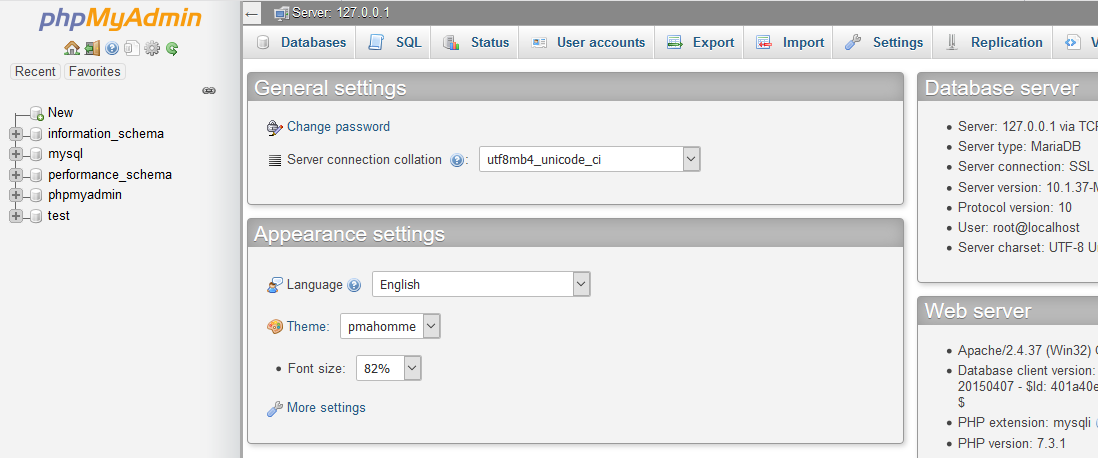
- #HOW TO RESET PHPMYADMIN ROOT PASSWORD HOW TO#
- #HOW TO RESET PHPMYADMIN ROOT PASSWORD WINDOWS 10#
- #HOW TO RESET PHPMYADMIN ROOT PASSWORD SOFTWARE#
- #HOW TO RESET PHPMYADMIN ROOT PASSWORD CODE#
- #HOW TO RESET PHPMYADMIN ROOT PASSWORD PASSWORD#
#HOW TO RESET PHPMYADMIN ROOT PASSWORD PASSWORD#
Note: No password is required at this stage as when we started MySQL we skipped the user privileges table. Note: The ampersand (&) at the end of the command is required.Īll we need to do now is to log into MySQL and set the password. I have tried various method of resetting the password but when I try m. Again, note that you will need to have sudo access for these commands so you don't need to worry about any user being able to reset the MySQL root password: sudo mysqld_safe -skip-grant-tables & I’ve got a raspberry pi with a phpmyadmin database. Next we need to start MySQL in safe mode - that is to say, we will start MySQL but skip the user privileges table. If you are using Ubuntu or Debian the command is as follows: sudo /etc/init.d/mysql stopįor CentOS, Fedora, and RHEL the command is: sudo /etc/init.d/mysqld stop If you liked this article, then please subscribe to our YouTube Channel for video tutorials.The first thing to do is stop MySQL.
#HOW TO RESET PHPMYADMIN ROOT PASSWORD HOW TO#
How to Run MySQL Queries through Windows Command Prompt.How to Write MySQL Commands to Export and Import Database.In order to reset the database password, you need to connect to the database server.

The steps below should be performed on the database server (the server instance hosting the database), which includes a mysql client. Please share your thoughts and suggestions in the comment section below. Reset the database password NOTE: A multi-tier environment typically consists of multiple servers. That’s it! I hope you got to know how to set MySQL Root password using phpMyAdmin and terminal. In the terminal, run the below command: mysqladmin -u root password PASSWORD_HEREĪfter this, set the value as ‘cookie’ for the $cfg variable. In my case, it’s path is D:\xampp\mysql\bin. If the path is not set, then open the terminal inside the MySQL installation directory. If you have set the MySQL path in your environment then you can run the MySQL queries directly in the command prompt. For this, you again need to revert your changes of file. The last option to reset the Root password is through the command line. Set again the ‘cookie’ value for the $cfg variable of your file and you are done. Replace the placeholder with the actual value. SET PASSWORD FOR = PASSWORD('PASSWORD_HERE') Head over to the phpMyAdmin, click on the ‘SQL’ from the top bar, and run the below query. If you want to try another way of changing a Root password, then first revert back the changes made in the file.
#HOW TO RESET PHPMYADMIN ROOT PASSWORD CODE#
However, there are 2 other ways to set the password for account. Find out how to reset MySQL's root password with this guide that includes detailed, step-by-step directions, relevant code snippets and links to related articles. This is the most efficient way of changing the Root password. Keep a note you have to use the same username and password in your database connection code for the applications. Enter the username as ‘root’ and password which you set in the above steps, it will log you inside the phpMyAdmin. Run the URL on the browser and this time you will be asked for entering username and password. Change this value to ‘cookie’ as follows. This variable should have a ‘config’ value set by default. Adjust the path as per your installations.

#HOW TO RESET PHPMYADMIN ROOT PASSWORD WINDOWS 10#
On my Windows 10 machine, I have XAMPP server installed and path is D:\xampp\phpMyAdmin\.

In the form, enter the password you want to set and click on the ‘Go’.Īfter these steps are done, head over to your editor and open the from the phpmyadmin directory. On the next screen, click on the ‘Change password’. Click on the ‘Edit privileges’ from the Action column of this row. We need the last account from the list with the User name as ‘root’ and the Host name as ‘localhost’. You will then see a list of user accounts. Most probably you can access it using Click on the ‘User Accounts’ from the top bar. Using phpMyAdmin, one can set the Root password in a few steps. It just makes developers life easy to manage the database, tables, table structures, queries, and so on.
#HOW TO RESET PHPMYADMIN ROOT PASSWORD SOFTWARE#
PhpMyAdmin is a fantastic software built for handling your MySQL databases.

I am going to show you 3 different ways of resetting the password. That being said, let’s take a look at how to set MySQL Root password. Though users rarely set the password on the local machine to access phpMyadmin, it’s always a good practice to do so. But on the local server, you have to set credentials yourself. For accessing phpMyAdmin on a live server, your hosting does set the credentials for you. When your application is live, you have to pass both username and password in order to access the database. In this article, I show you 3 possible ways to reset the password for your root account. Do you want to change a password for the root account of your MySQL server? Sometimes you may want to set a password for the account.


 0 kommentar(er)
0 kommentar(er)
